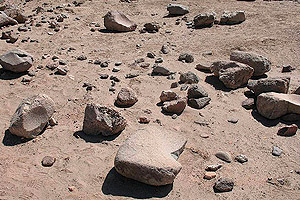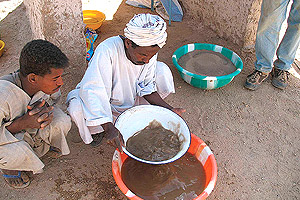Discoveries in Sudan reveal economic organization of an ancient African state—the kingdom of Kush
By William HarmsNews Office
 Above, large broken grindstones, nearly 2 feet in length, were found on the surface at the Hosh el-Guruf site. Hassan Ahmed Ali (below) pans for gold in al-Widay village, near the excavation site in Sudan. (Photos courtesy of the Oriental Institute)  | |
Archaeologists from the Oriental Institute have discovered a gold-processing center along the middle Nile in the Sudan, an installation that produced the precious metal sometime between 2000 and 1500 B.C. The center, along with a cemetery they discovered, documents extensive control by the first sub-Saharan kingdom, the kingdom of Kush.
The team found more than 55 grinding stones made of granite-like gneiss along the Nile at the site of Hosh el-Guruf, about 225 miles north of Khartoum. The region also was known as Nubia in ancient times. Groups of similar grinding stones have been found on desert sites, mostly in Egypt, where they were used to grind ore to recover the precious metal. The ground ore was likely washed with water nearby to separate the gold flakes.
“This large number of grinding stones and other tools used to crush and grind ore shows that the site was a center for organized gold production,” said Geoff Emberling, Director of the Oriental Institute Museum and a co-leader of the expedition. The research was funded by the National Geographic Society and the Packard Humanities Institute, which also offered to support all the other teams working in the Fourth Cataract salvage project, the location of the University’s expedition.
“Even today, panning for gold is a traditional activity in the area,” said expedition co-leader Bruce Williams, Research Associate in the Oriental Institute and a Systems Team Leader in NSIT at the University. “Water is a key ingredient for the production of gold, and it is possible that bits of gold ore were found in gravel deposits nearby in wadis (dry creek beds) and crushed on the site.”
The team also uncovered burials with artifacts in a cemetery they excavated, which suggest the region was part of the kingdom of Kush, which would have ruled an area much larger than previously believed. Such discoveries show that the kingdom was the first in sub-Saharan Africa to control a territory as much as 750 miles in length.
“This work is extremely exciting because it can give us our first look at the economic organization of this very important, but little-known ancient African state,” said Gil Stein, Director of the Oriental Institute. “Until now, virtually all that we have known about Kush came from the historical records of their Egyptian neighbors, and from explorations of monumental architecture and cemeteries at the Kushite capital city Kerma. The Oriental Institute excavations at Hosh el-Guruf will allow scholars to understand the rural sources of the riches of Kush.”
The University expedition is part of an international recovery project that is underway. Before archaeological sites are covered by the steadily rising Nile, expedition teams are working to find artifacts related to Kush and other civilizations that flourished in the area. The Hamdab or Merowe Dam, located at the downstream end of the Fourth Cataract, is flooding the area. The lake to be formed by this dam will flood about 100 miles of the Nile Valley in an area that had previously seen no archaeological work.
“Surveys suggest that there are as many as 2,500 archaeological sites to be investigated in the area. Fortunately, this is an international effort; teams from Sudan, England, Poland, Hungary, Germany and the United States have been working since 1996, with a large increase in the number of archaeologists working in the area since 2003,” Emberling said. The area will probably be flooded next year, but the team hopes to return for another season of exploration.
Stein noted, “The current excavations mark a return to Nubia for the Oriental Institute. The Institute played a key role in the large-scale international salvage excavations in Nubia during the 1960s in connection with the construction of the Aswan High dam. Materials from these rescue excavations in the Oriental Institute’s museum form one of the largest collections of scientifically excavated Nubian artifacts in the United States.”
The sites studied by Emberling and Williams provide important new information on the ancient Kingdom of Kush, which flourished from about 2000 to 1500 B.C.
“The Kingdom of Kush was unusual in that it was able to use the tools of power—military and governance—without having a system of writing, an extensive bureaucracy or numerous urban centers,” Emberling said. “Studying Kush helps scholars have a better idea of what statehood meant in an ancient context outside such established power centers of Egypt and Mesopotamia.” Among the artifacts they found in burials nearby at the site al-Widay were high-status pottery vessels that appear to have been made in the center of the kingdom, a city called Kerma, some 225 miles downstream.
The graves for the cemetery, which were for elite members of the community, included 90 closely packed, roughly constructed stone circles—covered shafts that were circular and lined with stones, a feature noted in the so-called Pan Graves of Lower Nubia and Egypt during the Second Intermediate Period, about 1700 B.C., said Williams. “These, and the broad-bottomed, black-topped cups they contained, are generally assigned to the Medjay, people of the Eastern Desert, who at times served as soldiers and police in Egypt.”
Williams noted, “A few of the tombs had the rectangular shafts of the later Classic Kerma burials, graceful tulip-shaped beakers and jars of Kerma-type, and even imported vessels from Egypt, as well as scarabs and faience and carnelian beads, and there were even several beds or biers.”
“Finds of Kerma materials at the Fourth Cataract was one of the major surprises of the salvage effort, and they suggest the leaders of Kush were able to expand their influence much further than was previously known, possibly including as much as 750 miles along the banks of the Nile.” he said.
The Oriental Institute team worked on sites that were in the concession of the mission from the Gdansk Archaeological Museum.
![[Chronicle]](/images/sidebar_header_oct06.gif)